Combining L- and X-Band SAR Interferometry to Assess Ground Displacements in Heterogeneous Coastal Environments: The Po River Delta and Venice Lagoon, Italy
Abstract
:1. Introduction
2. Study Site and Dataset
2.1. Study Site and Problem Statement
2.2. SAR Data
2.3. Ground Data
3. Methods
3.1. COSMO-SkyMed Persistent Scatterer Interferometry (PSI)
3.2. Short-Baseline SAR Interferometry of ALOS PALSAR
- Regions with a spatial coherence higher than 0.18 computed on the raw interferogram;
- areas with a spatial coherence higher than 0.88 computed on the filtered interferograms; and
- pixels with a standard deviation below 0.8 computed with a temporal least-square model regression on candidate PTs selected based on a temporal mean-to-standard deviation ratio of the co-registered SAR intensity images above 1.8 and a spectral correlation averaged over the single look complex stack of more than 0.38.
3.3. Calibration and Validation
3.4. COSMO-SkyMed and ALOS-PALSAR Integration
- The high accuracy of the displacements detected by X-band IPTA on even small-size anthropogenic structures scattered in the investigated area; and
- the high temporal coherence over the long time of L-band SBAS allowing for evaluating land displacements over natural environments, such as marshlands and crop-fields located in the investigated area.
4. Results and Discussion
4.1. Outcome from the Calibration-Validation Procedure
4.2. Comparison of L- and X-Band Results
4.3. Multi-Band Combined Results
- (1)
- (2)
- the significant difference between the displacement rates observed in the inner (by L-band SBAS) and the outer boundaries (by X-band IPTA) of each zone. Notice, for example, that at the northern tip of the Venice Lagoon the subsidence rate of the inner natural zone (Figure 12a) almost doubles the values characterizing the embankments (Figure 12d), i.e., on the average about −7 mm/yr for the former versus −4 mm/yr for the latter. Conversely, in the Po River Delta the farmland (Figure 12c) is subsiding at 5 mm/yr on the average, i.e., less than the embankments and houses located on the basin boundaries (Figure 12f) that are moving at −7 mm/yr.
5. Conclusions
Acknowledgments
Author Contributions
Conflicts of Interest
References
- Carbognin, L.; Teatini, P.; Tosi, L.; Strozzi, T.; Tomasin, A. Present relative sea level rise in the northern Adriatic coastal area. In Marine Research at CNR—Theme 3 “Coastal and Marine Spatial Planning”; Brugnoli, E., Cavarretta, G., Mazzola, S., Trincardi, F., Ravaioli, M., Santoleri, R., Eds.; CNR-DTA: Roma, Italy, 2011; pp. 1123–1138. [Google Scholar]
- Carbognin, L.; Teatini, P.; Tomasin, A.; Tosi, L. Global change and relative sea level rise at Venice: What impact in term of flooding. Clim. Dyn. 2010, 35, 1055–1063. [Google Scholar] [CrossRef]
- Tosi, L.; Teatini, P.; Strozzi, T.; Da Lio, C. Relative land subsidence of the Venice coastland, Italy. In Engineering Geology for Society and Territory; Lollino, G., Ed.; Springer: Cham, Switzerland, 2014; Volume 4, pp. 171–173. [Google Scholar]
- Tosi, L.; Teatini, P.; Strozzi, T.; Carbognin, L.; Brancolini, G.; Rizzetto, F. Ground surface dynamics in the northern Adriatic coastland over the last two decades. Rend. Lincei Sci. Fis. 2010, 21, 115–129. [Google Scholar] [CrossRef]
- Veneto GPS Network. Available online: http://retegnssveneto.cisas.unipd.it/Web/index.php (accessed on 25 November 2015).
- Tosi, L.; Carbognin, L.; Teatini, P.; Strozzi, T.; Wegmüller, U. Evidence of the present relative land stability of Venice, Italy, from land, sea, and space observations. Geophys. Res. Lett. 2002, 29. [Google Scholar] [CrossRef]
- Ferretti, A.; Prati, C.; Rocca, F. Permanent scatterers in SAR interferometry. IEEE Trans. Geosci. Remote Sens. 2001, 39, 8–20. [Google Scholar] [CrossRef]
- Werner, C.; Wegmüller, U.; Strozzi, T.; Wiesmann, A. Interferometric point target analysis for deformation mapping. In Proceedings of the IEEE International Geoscience and Remote Sensing Symposium (IGARSS 2003), Toulouse, France, 21–25 July 2003; pp. 4362–4364.
- Teatini, P.; Tosi, L.; Strozzi, T.; Carbognin, L.; Wegmüller, U.; Rizzetto, F. Mapping regional land displacements in the Venice coastland by an integrated monitoring system. Remote Sens. Environ. 2005, 98, 403–413. [Google Scholar] [CrossRef]
- Teatini, P.; Strozzi, T.; Tosi, L.; Wegmüller, U.; Werner, C.; Carbognin, L. Assessing short- and long-time displacements in the Venice coastland by synthetic aperture radar interferometric point target analysis. J. Geophys. Res. Earth Surface 2007, 112. [Google Scholar] [CrossRef]
- Teatini, P.; Tosi, L.; Strozzi, T. Quantitative evidence that compaction of Holocene sediments drives the present land subsidence of the Po Delta, Italy. J. Geophys. Res. Solid Earth 2011, 116. [Google Scholar] [CrossRef]
- Strozzi, T.; Teatini, P.; Tosi, L. TerraSAR-X reveals the impact of the mobile barrier works on the Venice coastal stability. Remote Sens. Environ. 2009, 113, 2682–2688. [Google Scholar] [CrossRef]
- Tosi, L.; Teatini, P.; Strozzi, T. Natural versus anthropogenic subsidence of Venice. Sci. Rep. 2013, 3. [Google Scholar] [CrossRef] [PubMed]
- Teatini, P.; Tosi, L.; Strozzi, T.; Carbognin, L.; Cecconi, G.; Rosselli, R.; Libardo, S. Resolving land subsidence within the Venice Lagoon by persistent scatterer SAR interferometry. Phys. Chem. Earth 2012, 40–41, 72–79. [Google Scholar] [CrossRef]
- Tosi, L.; Teatini, P.; Carbognin, L.; Brancolini, G. Using high resolution data to reveal depth-dependent mechanisms that drive land subsidence: The Venice coast, Italy. Tectonophysics 2009, 474, 271–284. [Google Scholar] [CrossRef]
- Gambolati, G.; Putti, M.; Teatini, P.; Camporese, M.; Ferraris, S.; Gasparetto-Stori, G.; Nicoletti, V.; Rizzetto, F.; Silvestri, S.; Tosi, L. Peatland oxidation enhances subsidence in the Venice watershed. EOS Trans. AGU 2005, 86, 217–224. [Google Scholar] [CrossRef]
- Teatini, P.; Gambolati, G.; Tosi, L. A new 3-D non-linear model of the subsidence of Venice. In Land Subsidence; Barends, F.B.J., Ed.; IAHS Publishing: Wallingford, UK, 1995; pp. 353–361. [Google Scholar]
- Strozzi, T.; Teatini, P.; Tosi, L.; Wegmüller, U.; Werner, C. Land subsidence of natural transitional environments by satellite radar interferometry on artificial reflectors. J. Geophys. Res. Earth Surface 2013, 118, 1177–1191. [Google Scholar] [CrossRef]
- Kourkouli, P.; Wegmüller, U.; Teatini, P.; Tosi, L.; Strozzi, T.; Wiesmann, A.; Tansey, K. Ground deformation monitoring over Venice Lagoon using combined DInSAR/PSI techniques. In Engineering Geology for Society and Territory; Lollino, G., Ed.; Springer: Cham, Switzerland, 2014; Volume 4, pp. 181–186. [Google Scholar]
- Rosen, P.A.; Hensley, S.; Zebker, H.A.; Webb, F.H.; Fielding, E.J. Surface deformation and coherence measurements of Kilauea Volcano, Hawaii, from SIR-C radar interferometry. J. Geophys. Res. 1996, 101. [Google Scholar] [CrossRef]
- Wegmüller, U.; Werner, C.; Strozzi, T.; Wiesmann, A. Monitoring mining induced surface deformation. In Proceedings of the IEEE International Geoscience and Remote Sensing Symposium (IGARSS 2004), Anchorage, AK, USA, 20–24 September 2004; pp. 1933–1935.
- Strozzi, T.; Wegmüller, U.; Werner, C.; Wiesmann, A.; Spreckels, V. JERS SAR interferometry for land subsidence monitoring. IEEE Trans. Geosci. Remote Sens. 2003, 41, 1702–1708. [Google Scholar] [CrossRef]
- Nitti, D.O.; De Vitis, L.; Bovenga, F.; Nutricato, R.; Refice, A.; Wasowski, J. Multi-temporal L-band SAR interferometry confirms C-band spatial patterns of subsidence in the ancient Wieliczka Salt Mine (Unesco Heritage Site, Poland). In Proceedings of the Fringe 2009 Workshop, Frascati, Italy, 4 December 2009.
- Luo, Q.; Perissin, D.; Zhang, Y.; Jia, Y. L- and X-Band multi-temporal InSAR analysis of Tianjin subsidence. Remote Sens. 2014, 6, 7933–7951. [Google Scholar] [CrossRef]
- Chen, F.; Lin, H.; Hu, X. Slope superficial displacement monitoring by small baseline SAR interferometry using data from L-band ALOS PALSAR and X-band TerraSAR: A case study of Hong Kong, China. Remote Sens. 2014, 6, 1564–1586. [Google Scholar] [CrossRef]
- Cianflone, G.; Tolomei, C.; Brunori, C.A.; Dominici, R. InSAR time series analysis of natural and anthropogenic coastal plain subsidence: The case of Sibari (Southern Italy). Remote Sens. 2015, 7, 16004–16023. [Google Scholar] [CrossRef]
- Berardino, P.; Fornaro, G.; Lanari, R.; Sansosti, E. A new algorithm for surface deformation monitoring based on small baseline differential SAR interferograms. IEEE Trans. Geosci. Remote Sens. 2002, 40, 2375–2383. [Google Scholar] [CrossRef]
- Doglioni, C. Some remarks on the origin of foredeeps. Tectonophysics 1993, 228, 1–20. [Google Scholar] [CrossRef]
- Carminati, E.; Doglioni, C.; Scrocca, D. Apennines subduction-related subsidence of Venice (Italy). Geophys. Res. Lett. 2003, 30. [Google Scholar] [CrossRef]
- MAGNET GPS Network. Available online: http://geodesy.unr.edu/billhammond/gpsnetmap/GPSNetMap.html (accessed on 25 November 2015).
- Torresan, S.; Critto, A.; Rizzi, J.; Marcomini, A. Assessment of coastal vulnerability to climate change hazards at the regional scale: The case study of the North Adriatic Sea. Nat. Hazards Earth Syst. Sci. 2012, 12, 2347–2368. [Google Scholar] [CrossRef]
- Sestini, G. Land subsidence and sea—level rise: The case of the Po Delta Region, Italy. In Sea Level Rise and Coastal Subsidence: Causes, Consequences, and Strategies; Milliman, J.D., Haq, B.U., Eds.; Springer: Dordrecht, The Netherlands, 1996; pp. 235–248. [Google Scholar]
- Carbognin, L.; Teatini, P.; Tosi, L. Relative land subsidence in the lagoon of Venice, Italy, at the beginning of the new millennium. J. Mar. Syst. 2004, 51, 345–353. [Google Scholar] [CrossRef]
- Jet Propulsion Laboratory—GPS Time Series. Available online: http://sideshow.jpl.nasa.gov/post/series.html (accessed on 25 November 2015).
- SOPAC GPS Data. Available online: http://sopac.ucsd.edu/map.shtml (accessed on 25 November 2015).
- FReDNet GPS Network. Available online: http://frednet.crs.inogs.it/ItalianSite/XFReDNetHome.htm (accessed on 25 November 2015).
- Jarvis, A.; Reuter, H.I.; Nelson, A.; Guevara, E. Hole-Filled SRTM for the Globe 2008 Version 4. Available online: http://srtm.csi.cgiar.org (accessed on 19 August 2008).
- Wegmüller, U.; Strozzi, T.; Werner, C. Ionespheric path delay estimation using split-beam interferometry. In Proceedings of the IGARSS 2012, Munich, Germany, 12 January 2012; pp. 3631–3634.
- Goldstein, R.; Werner, C. Radar ice motion interferometry. In Proceedings of the Third ERS Symposium, Florence, Italy, 17–21 March 1997; pp. 969–972.
- Strozzi, T.; Wegmüller, U.; Tosi, L.; Bitelli, G.; Spreckels, V. Land subsidence monitoring with differential SAR interferometry. Photogramm. Eng. Remote Sens. 2001, 67, 1261–1270. [Google Scholar]
- Teatini, P.; Tosi, L.; Strozzi, T. Comment on “Recent subsidence of the Venice Lagoon from continuous GPS and interferometric synthetic aperture radar”. Geochem. Geophys. Geosys. 2012, 13. [Google Scholar] [CrossRef]
- Cressie, N. Statistics for Spatial Data; John Wiley & Sons: New York, NY, USA, 1991. [Google Scholar]
- Zanello, F.; Teatini, P.; Putti, M.; Gambolati, G. Long term peatland subsidence: Experimental study and modeling scenarios in the Venice coastland. J. Geophys. Res. Earth Surface 2011, 116. [Google Scholar] [CrossRef]
- Kirwan, M.L.; Guntenspergen, G.R.; D’Alpaos, A.; Morris, J.T.; Mudd, S.M.; Temmerman, S. Limits on the adaptability of coastal marshes to rising sea level. Geophys. Res. Lett. 2010, 37. [Google Scholar] [CrossRef]
- D'Alpaos, A.; Da Lio, C.; Marani, M. Biogeomorphology of tidal landforms: Physical and biological processes shaping the tidal landscape. Ecohydrology 2012, 5. [Google Scholar] [CrossRef]
- Tosi, L.; Rizzetto, F.; Bonardi, M.; Donnici, S.; Serandrei Barbero, R.; Toffoletto, F. Note Illustrative Della Carta Geologica D’Italia Alla Scala 1:50.000, Foglio 128 Venezia; APAT—Dipartimento Difesa del Suolo, Servizio Geologico d’Italia: Roma, Italy, 2007; p. 164. [Google Scholar]
- Bondesan, M.; Favero, V.; Viñals, M.J. New evidence on the evolution of the Po-delta coastal plain during the Holocene. Quat. Int. 1995, 29–30, 105–110. [Google Scholar] [CrossRef]
- Carminati, E.; Di Donato, G. Separating natural and anthropogenic vertical movements in fast subsiding areas: The Po Plain (N. Italy) case. Geophys. Res. Lett. 1999, 26, 2291–2294. [Google Scholar] [CrossRef]
- Wolstencroft, M.; Shen, Z.; Törnqvist, T.E.; Milne, G.A.; Kulp, M. Understanding subsidence in the Mississippi Delta region due to sediment, ice, and ocean loading: Insights from geophysical modeling. J. Geophys. Res. Solid Earth 2014, 119, 3838–3856. [Google Scholar] [CrossRef]
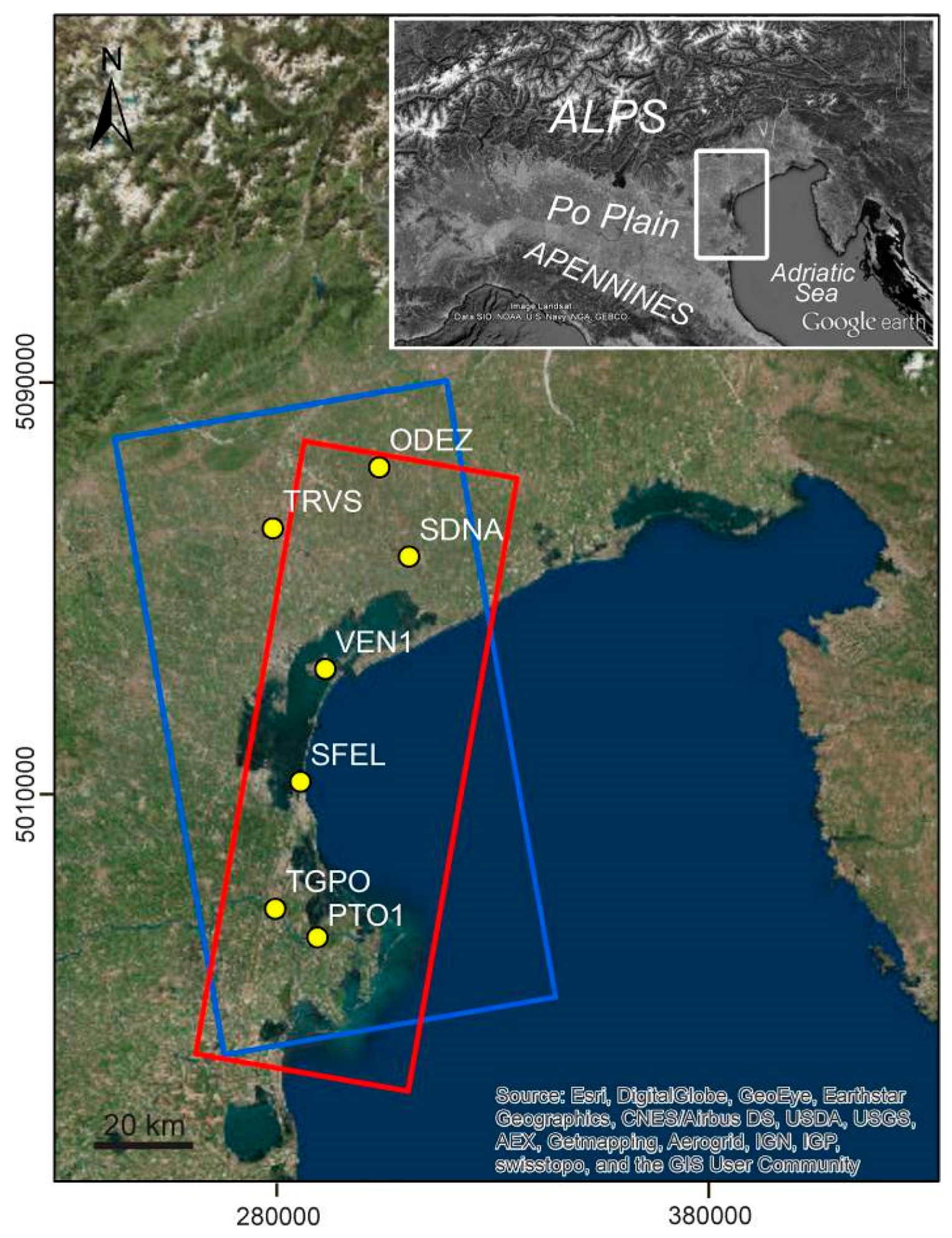
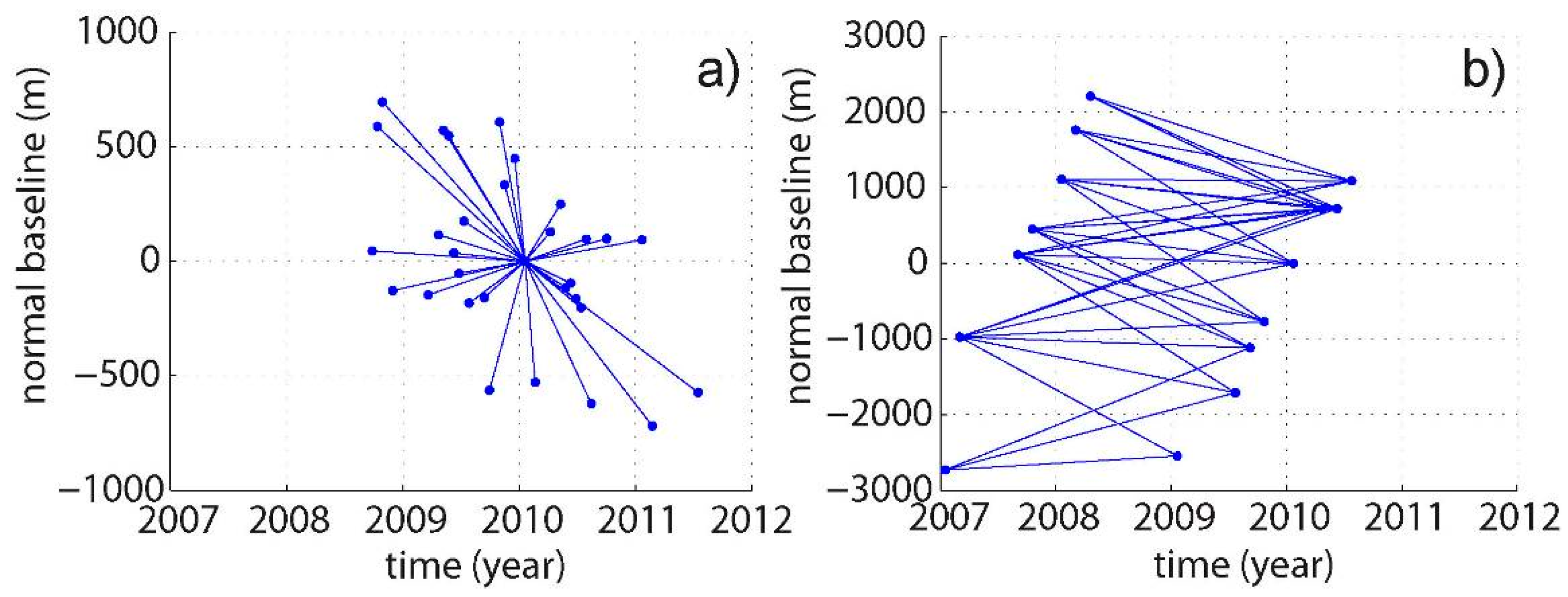
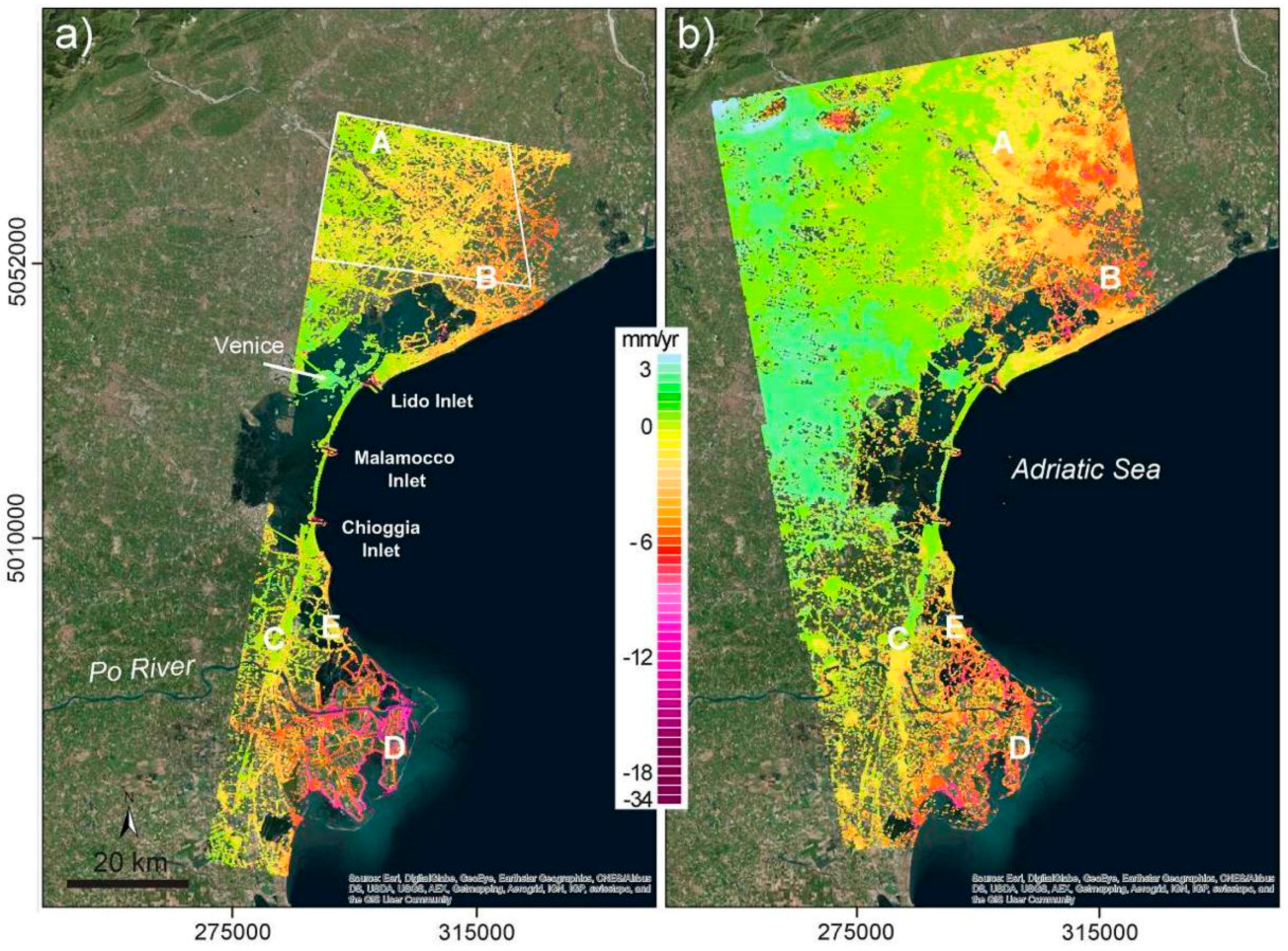
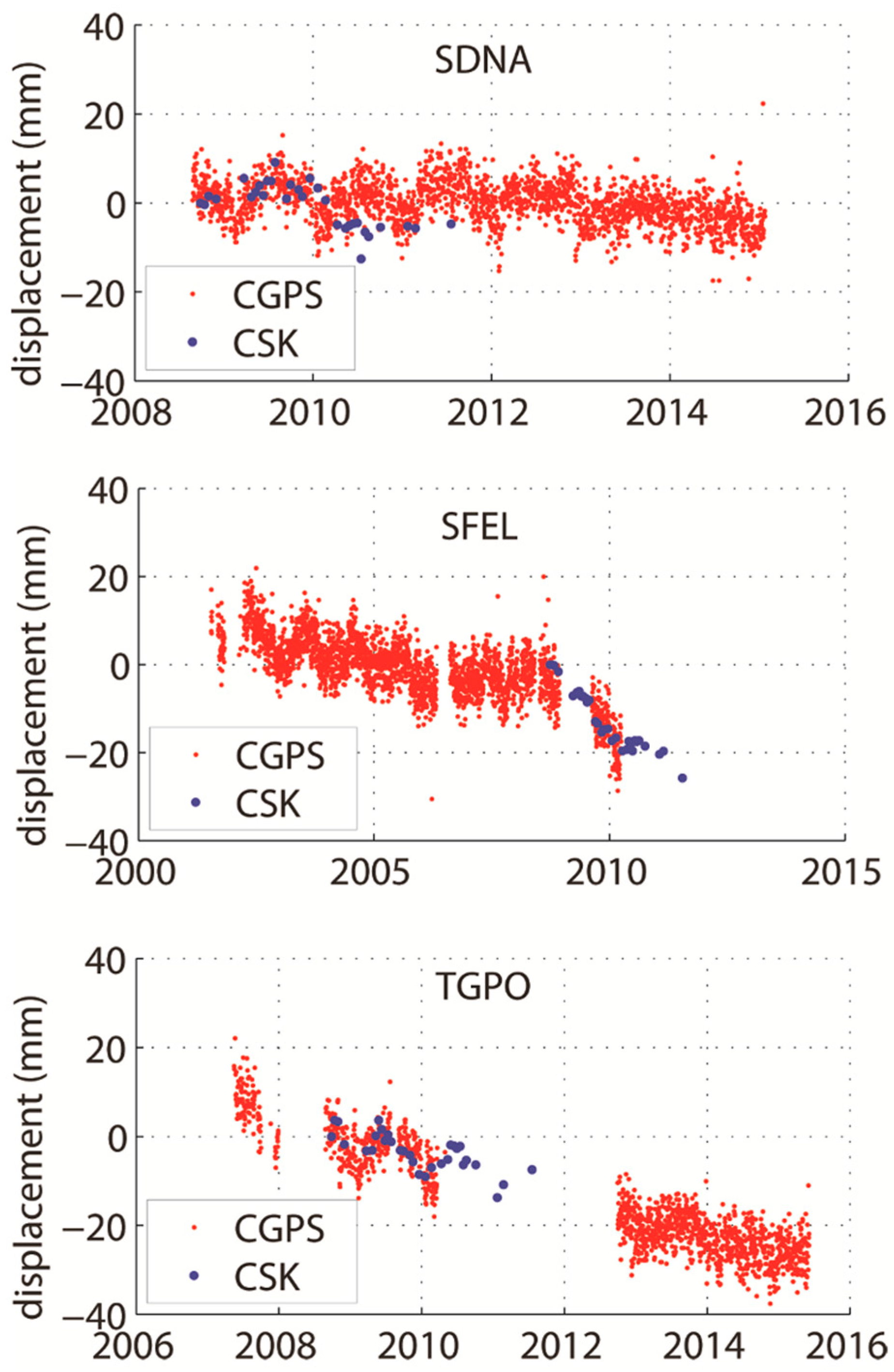
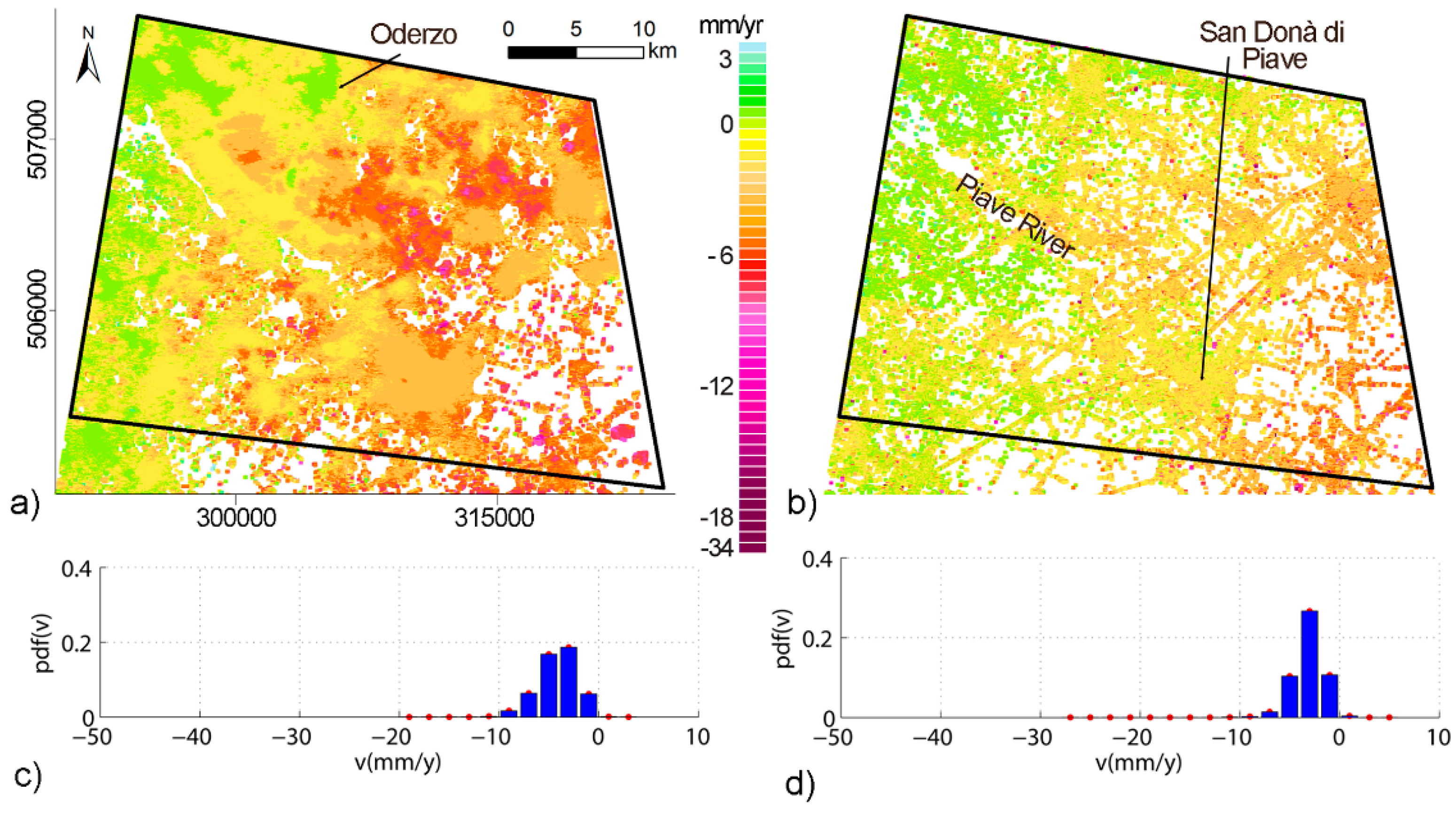
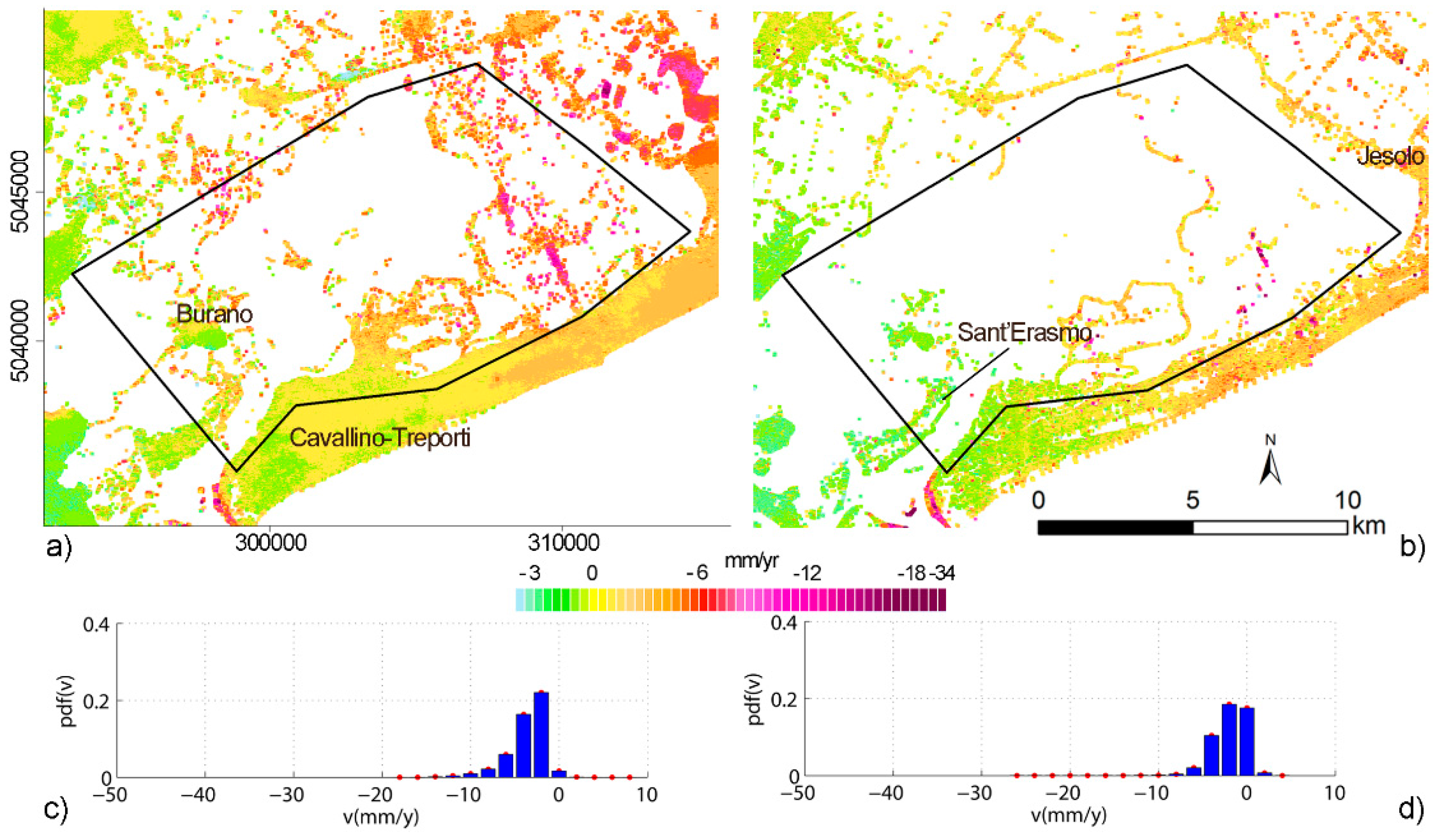
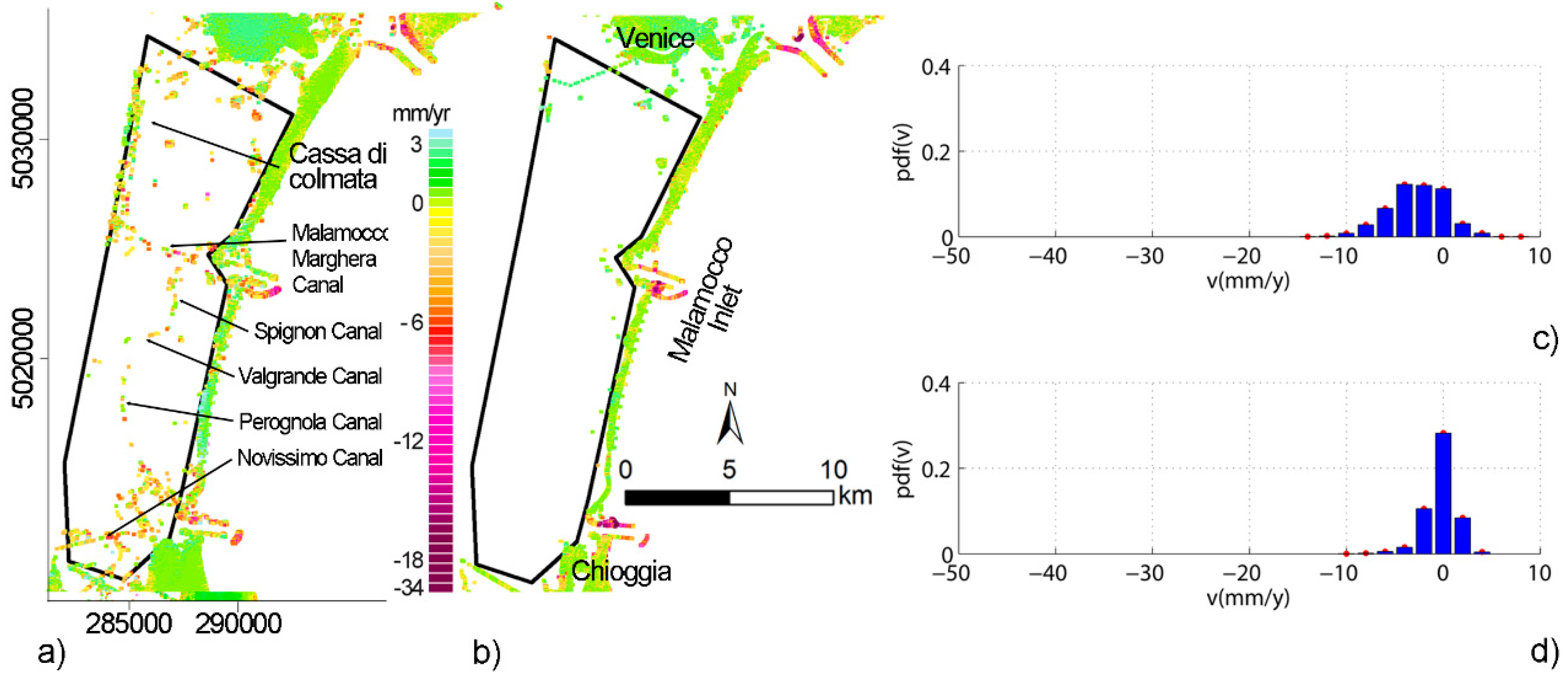
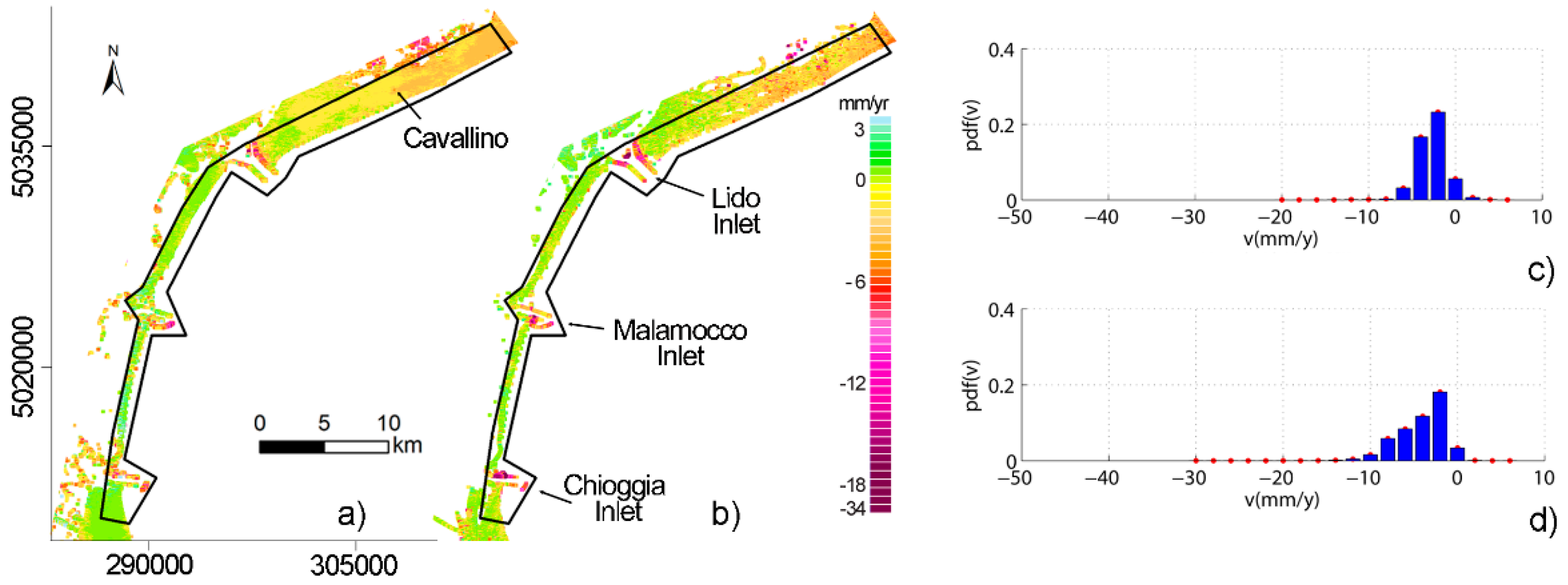
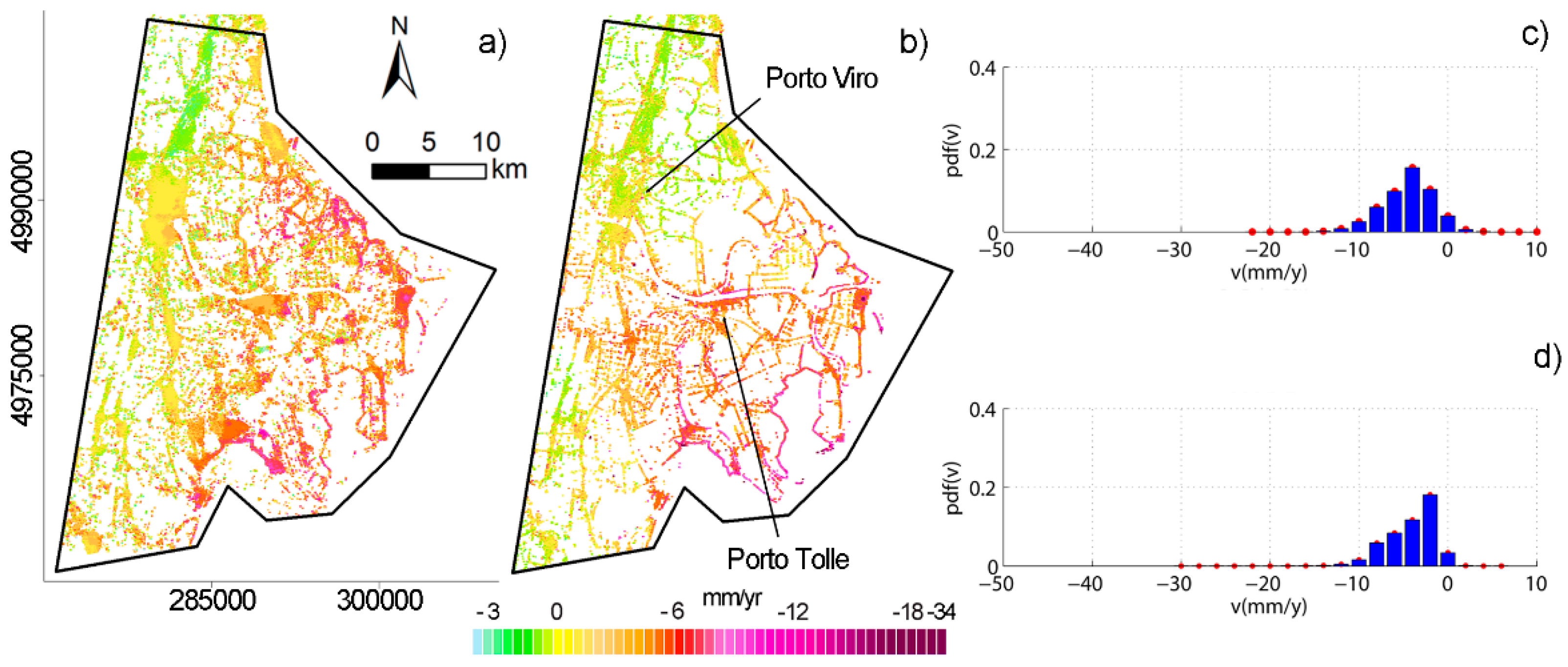
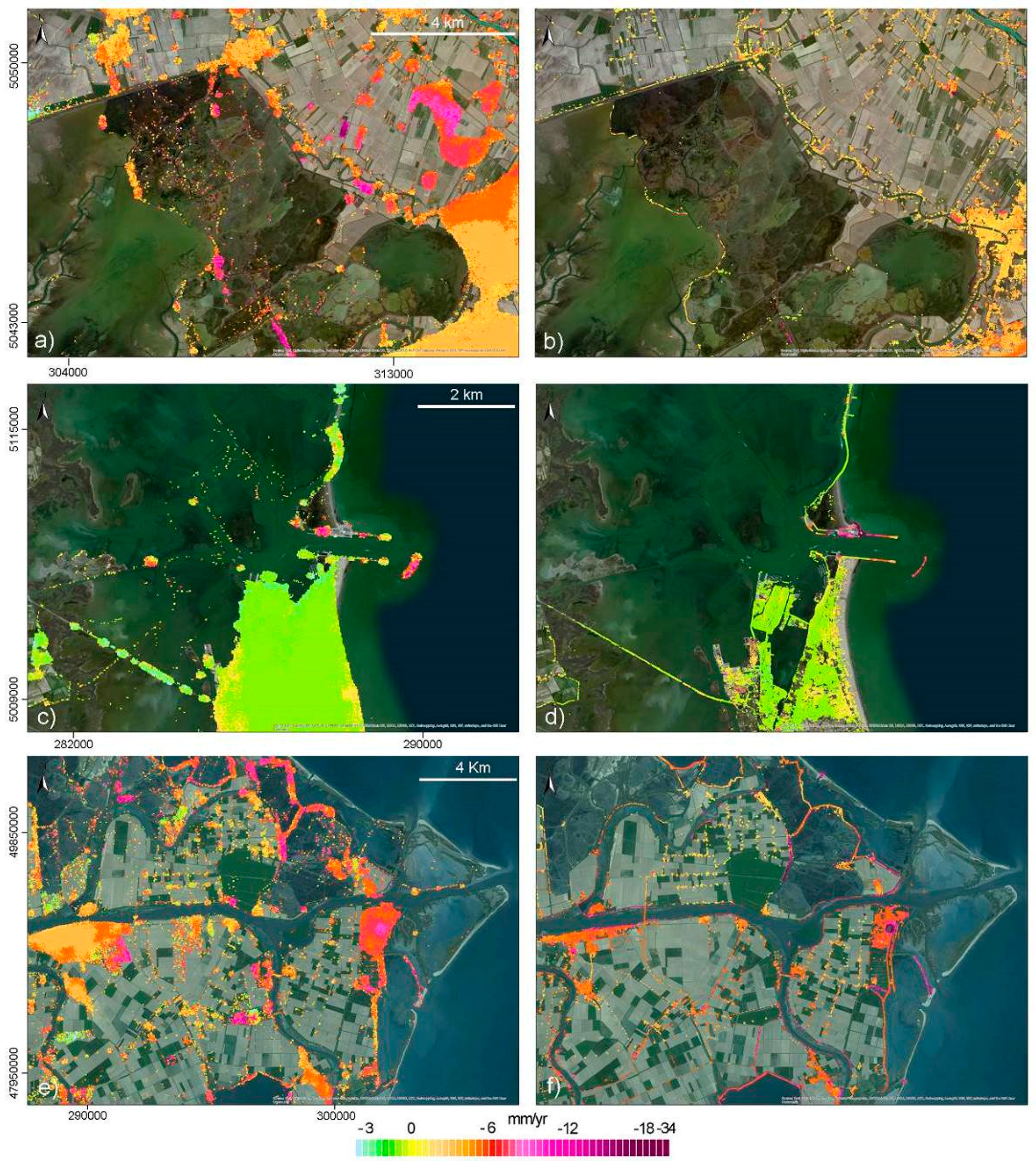
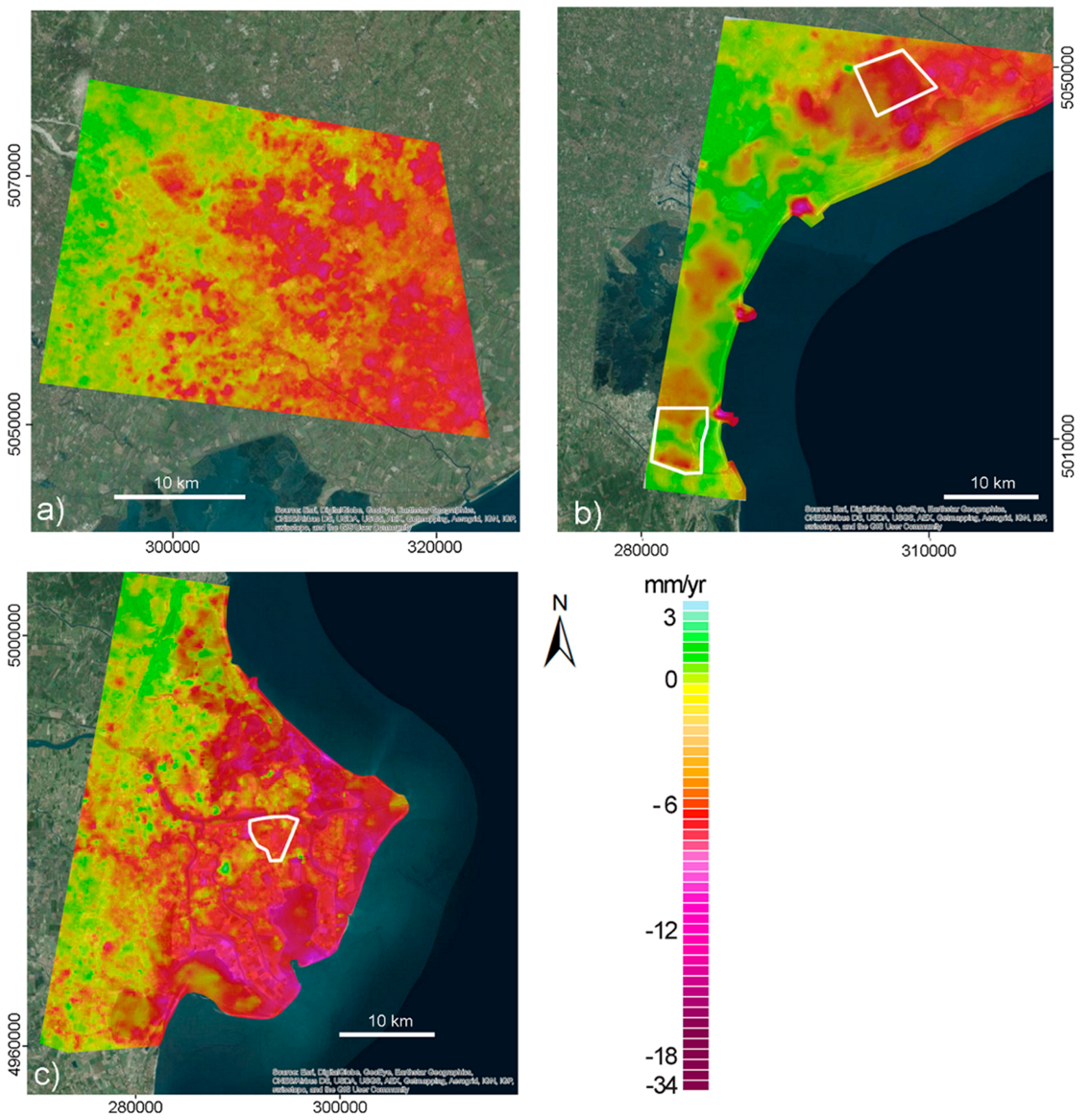
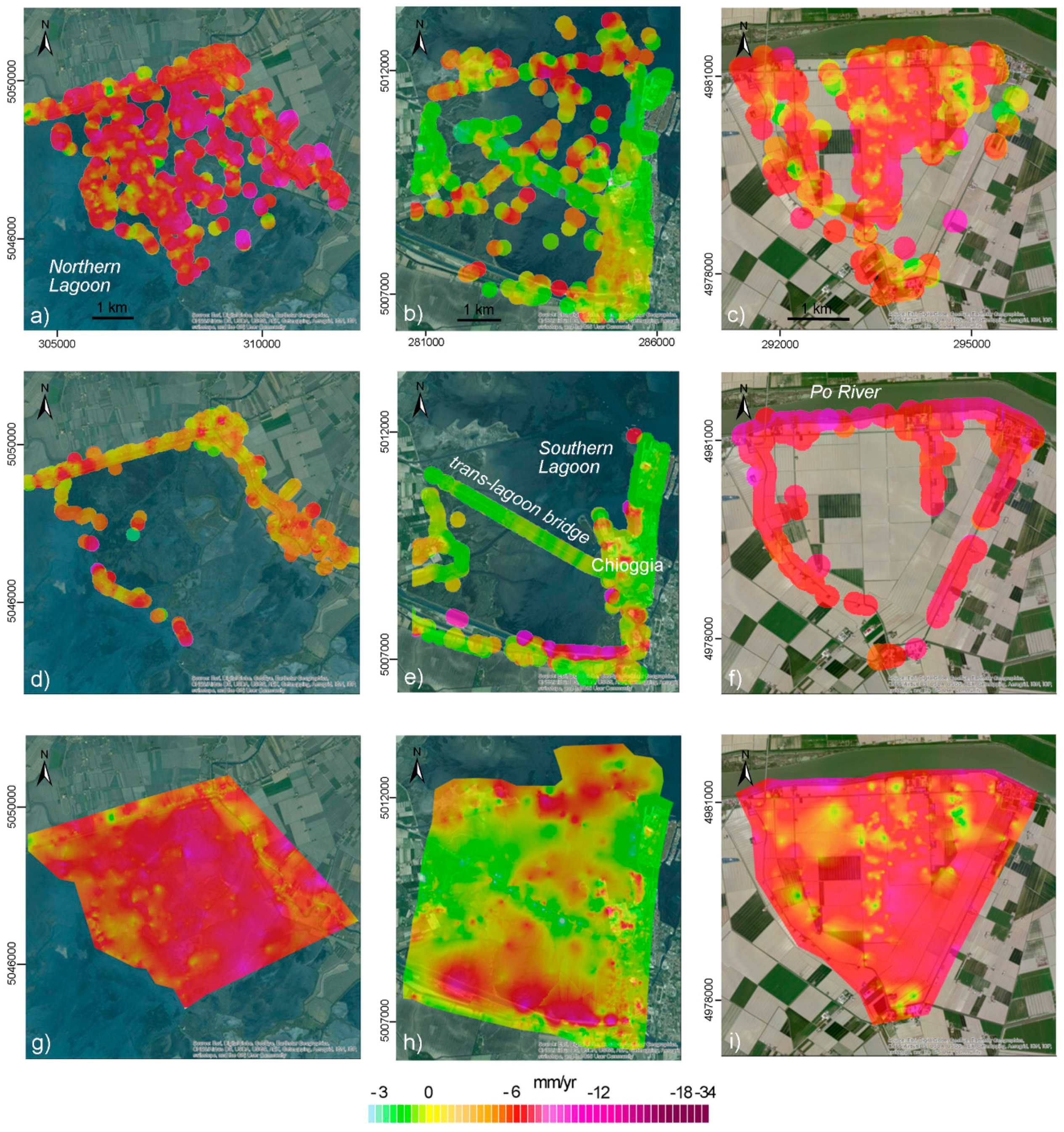
| Station ID | Station Name | Lon (deg) | Lat (deg) | Time Span (years) | Used Time Span (years) | E (mm/yr) | N (mm/yr) | UP (mm/yr) |
|---|---|---|---|---|---|---|---|---|
| TRVS | Treviso | 12.222 | 45.680 | 2009–2015 | 2009–2012 | 21.1 | 17.5 | −1.0 |
| ODEZ | Oderzo | 12.489 | 45.788 | 2011–2015 | 2011–2014 | 20.5 | 16.8 | −2.3 |
| VEN1 | Venice | 12.354 | 45.431 | 2008–2015 | 2008–2011 | 21.1 | 16.6 | −0.6 |
| SFEL | San Felice | 12.291 | 45.230 | 2001–2010 | 2007–2010 | 16.9 | 13.6 | −8.0 |
| PTO1 | Porto Tolle | 12.334 | 44.952 | 2011–2015 | 2011–2014 | 20.8 | 16.9 | −4.9 |
| SDNA | San Donà di Piave | 12.564 | 45.630 | 2008–2015 | 2008–2012 | 21.3 | 17.3 | −1.9 |
| TGPO | Taglio di Po | 12.228 | 45.003 | 2007–2015 | 2007–2011 | 21.3 | 16.2 | −5.2 |
| CGPS Station | Time Span | CGPS LOS (mm/yr) | IPTAu (mm/yr) | IPTAc (mm/yr) | #PTs |
|---|---|---|---|---|---|
| ODEZ | 2011–2015 | −2.3 | −0.3 ± 0.5 | −2.2 ± 0.5 | 31 |
| PTO1 | 2011–2015 | −4.3 | −4.7 ± 0.6 | −5.1 ± 0.6 | 66 |
| VEN1 | 2008–2011 | −0.6 | 0.1 ± 0.9 | −0.7 ± 0.8 | 10 |
| CGPS Station | Time Span | CGPS LOS (mm/yr) | SBASu (mm/yr) | SBASc (mm/yr) | #Pixels |
|---|---|---|---|---|---|
| TRVS | 2009–2015 | −0.8 | −1.8 ± 0.1 | −1.0 ± 0.1 | 15 |
| PTO1 | 2011–2015 | −3.7 | −3.5 ± 0.1 | −4.2 ± 0.1 | 9 |
| VEN1 | 2008–2011 | −0.6 | 0.5 ± 0.1 | −0.5 ± 0.1 | 20 |
| CGPS Station | Period | CGPS LOS (mm/yr) | SBASc (mm/yr) | #Pixel |
|---|---|---|---|---|
| TGPO | 2007–2011 | −4.4 | −4.1 ± 0.2 | 13 |
| ODEZ | 2011–2015 | −1.5 | −1.9 ± 0.1 | 16 |
| 250-m Circle Area | 500-m Circle Area | |||
|---|---|---|---|---|
| SITE | IPTAc (mm/yr) | SBASc (mm/yr) | IPTAc (mm/yr) | SBASc (mm/yr) |
| A | −1.0 ± 0.7 | −1.0 ± 0.1 | −0.9 ± 0.7 | −1.1 ± 0.1 |
| B | −6.4 ± 1.7 | −6.7 ± 0.4 | −6.2 ± 1.5 | −6.6 ± 0.5 |
| C | −1.2 ± 0.9 | −1.2 ± 0.4 | −1.6 ± 1.1 | −1.3 ± 0.6 |
| D | −6.2 ± 1.1 | −6.2 ± 0.6 | −6.8 ± 1.6 | −6.8 ± 1.0 |
| E | −1.6 ± 0.7 | −3.1 ± 0.3 | −2.1 ± 0.9 | −3.4 ± 0.5 |
| Station ID | GPS Time Span (years) | GPS LOS ALOS (mm/yr) | GPS LOS CSK (mm/yr) | L-Band 2007–2010 (mm/yr) | X-Band 2008–2011 (mm/yr) | Regional Multi-Band (2007–2011) (mm/yr) |
|---|---|---|---|---|---|---|
| TRVS | 2009–2012 | −0.8 | −0.8 | −1.0 ± 0.1 | n.a. | n.a. |
| ODEZ | 2011–2014 | −1.6 | −2.3 | −1.9 ± 0.1 | −2.2 ± 0.5 | −2.1 |
| VEN1 | 2008–2011 | −0.6 | −0.7 | −0.5 ± 0.1 | −0.7 ± 0.8 | −0.6 |
| SFEL | 2007–2010 | −2.3 | −7.4 | −2.1 ± 0.8 | −6.1 ± 0.2 | −3.4 |
| PTO1 | 2011–2014 | −3.8 | −4.3 | −4.2 ± 0.1 | −5.1 ± 0.6 | −4.9 |
| SDNA | 2008–2012 | −2.6 | −1.5 | −5.0 ± 0.1 | −3.4 ± 0.4 | −3.9 |
| TGPO | 2007–2011 | −4.4 | −4.3 | −4.1 ± 0.2 | −4.1 ± 0.8 | −4.1 |
© 2016 by the authors; licensee MDPI, Basel, Switzerland. This article is an open access article distributed under the terms and conditions of the Creative Commons by Attribution (CC-BY) license (http://creativecommons.org/licenses/by/4.0/).
Share and Cite
Tosi, L.; Da Lio, C.; Strozzi, T.; Teatini, P. Combining L- and X-Band SAR Interferometry to Assess Ground Displacements in Heterogeneous Coastal Environments: The Po River Delta and Venice Lagoon, Italy. Remote Sens. 2016, 8, 308. https://doi.org/10.3390/rs8040308
Tosi L, Da Lio C, Strozzi T, Teatini P. Combining L- and X-Band SAR Interferometry to Assess Ground Displacements in Heterogeneous Coastal Environments: The Po River Delta and Venice Lagoon, Italy. Remote Sensing. 2016; 8(4):308. https://doi.org/10.3390/rs8040308
Chicago/Turabian StyleTosi, Luigi, Cristina Da Lio, Tazio Strozzi, and Pietro Teatini. 2016. "Combining L- and X-Band SAR Interferometry to Assess Ground Displacements in Heterogeneous Coastal Environments: The Po River Delta and Venice Lagoon, Italy" Remote Sensing 8, no. 4: 308. https://doi.org/10.3390/rs8040308
APA StyleTosi, L., Da Lio, C., Strozzi, T., & Teatini, P. (2016). Combining L- and X-Band SAR Interferometry to Assess Ground Displacements in Heterogeneous Coastal Environments: The Po River Delta and Venice Lagoon, Italy. Remote Sensing, 8(4), 308. https://doi.org/10.3390/rs8040308








